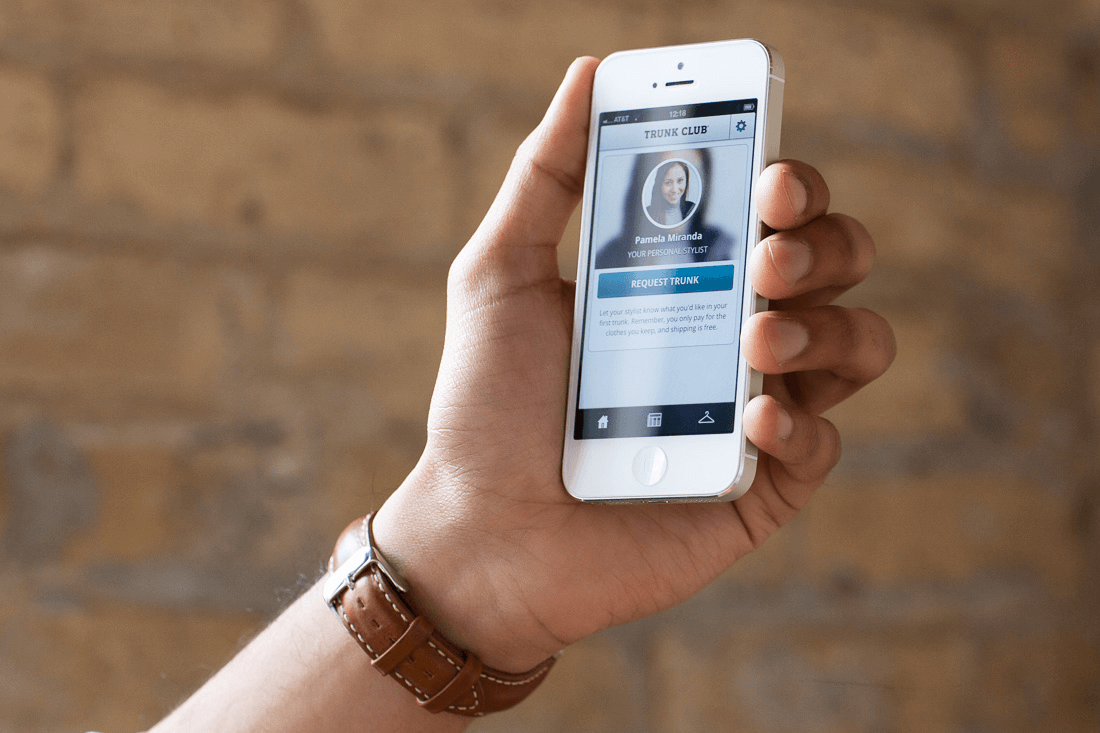Trunk Club Increased Mobile App Conversions 43% By Adding This Step
Mobile app optimization helps the Trunk Club team ensure that their app is efficient at converting browsers to customers, but it also helped them with an important discovery—finding the right customers to focus on, which means stylists can focus their attention on customers that are most likely to purchase clothing from their trunks.

Shana Rusonis

The digital shopping revolution isn’t just around the corner; it’s here. Just ask Trunk Club, an innovative retailer putting a personal, human twist on the digital shopping experience.
At Trunk Club, mobile is at the forefront of their business of “scaling interpersonal relationships”. The service pairs each member with a personal stylist, who puts together ‘trunks’ of clothing personalized to the member’s unique clothing style.
Trunk Club’s mobile app helps stylists understand their members’ readiness to buy or try new items, learn their preferences, and educate them on how Trunk Club’s shopping model works.
Mobile app optimization helps the Trunk Club team ensure that their app is efficient at converting browsers to customers, but it also helped them with an important discovery—finding the right customers to focus on, which means stylists can focus their attention on customers that are most likely to purchase clothing from their trunks.
By practicing mobile app A/B testing, Trunk Club was able to dramatically improve mobile app conversions and their e-commerce funnel efficiency for both stylists and members. All told, a series of tests increased stylist efficiency by 90% and increasing the likelihood of trunk shipment by 43%.
Trunk Club’s Challenge with Mobile Shopping
Trunk Club’s Director of Product, Justin Hughes, states that there are two unique challenges that have emerged with Trunk Club’s mobile app strategy:
- The shoppers are in a browse, not buy, mental state
- The mobile shoppers send mixed signals, which clutter Trunk Club stylists’ workflows
“If members are just there to window shop, it really cuts into our stylists’ time,” says Justin Hughes, Director of Product at Trunk Club. “We have a lot of people sign up and immediately request a bunch of things via the [Trunk Club] app. That requesting process can be painful for the stylist because it generates a lot of noise, when a lot of the guys aren’t actually interested in receiving the product.”

Trunk Club’s mobile app puts a stylist in members’ pockets.
So the product team at Trunk Club wondered: As the company grows, how could they scale their customer-stylist interactions on mobile and make them as efficient as possible?
They used Optimizely to find out.
The Experiment
With this questions in mind, Justin and the Trunk Club engineering team ran an experiment on their iOS app experience that helped them to increase stylist efficiency by 90%.
Since mobile users are often exploring rather than buying, the Trunk Club team wanted to experiment with different app mechanics that would help them to separate window shoppers from serious buyers. Requiring a credit card was one potential option for separating the browsing user from a user with strong purchase intent.
Hypothesis: Requiring a credit card on file before shipping a ‘trunk’ of merchandise will generate more productive leads for the stylists to pursue.
This experiment tested requiring credit card information versus not requiring credit card information at all before requesting a trunk. In either case, the card isn’t charged until a member decides to keep an item of clothing in their trunk.

Requesting a trunk: No credit card required (Left) versus requiring payment information (Right)
Results: Requiring credit card information led to fewer overall conversions, but the users that requested a trunk were more qualified and converted to purchases at a higher rate—the stylist and customer were 43% more likely to connect and ship a trunk of clothing, a key step in Trunk Club’s customer conversion funnel.
The experiment provided stylists with more productive leads. “We saw about half as many trunk requests come through—but then we were twice as likely to actually convert those trunk requests [to shipments],” says Hughes.
This was a tremendous win both for the stylists, who are focused on offering a high level of service to thousands of new members each day, and for the Trunk Club customer, who was more likely to understand that requesting a trunk was an action that required a purchase intent, and more likely to move further down the purchase funnel after requesting a trunk in the app.
Business Impact
The credit card gate brought the Trunk Club product team and stylists invaluable information that helps both groups up their games. The product team now has a new user experience that allows members to engage while still generating to qualified trunk requests, and the stylists have the qualified leads they need to offer exceptional—and 90% more efficient—personal service.
“We’re trying to take a stressful, painful experience and make it as easy as possible, and Optimizely helps us do that.” —Mike Cruz, VP of Engineering
Trunk Club continues to run experiments that refine their product experience and validate their overall technology strategy of offering personal, on-the-go service to their customers. “We’re trying to take a stressful, painful experience and make it as easy as possible,” says Cruz. “And Optimizely helps us do that.”
